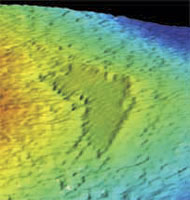发现大型南极冰下湖泊
|
Lost lakes. Credit: M. Studinger
Frozen Land O' LakesBy Mason Inman A new survey of eastern Antarctica has revealed a surprising find: two lakes buried beneath a 4-kilometer-thick ice sheet that rival the famous Lake Vostok in size. The lakes may hold exotic life, and their position along ancient fault lines could shed light on how a nearby mountain range formed. Earth scientists have so far spied about 145 subglacial lakes in Antarctica. Sandwiched between the ice above and bedrock below, the lakes stay liquid due to a combination of geothermal heat and the crushing pressure of the ice sheet. Lake Vostok, by far the largest of these lakes, is well-mapped, and a Russian team is now drilling through its ice cap in hopes of finding life inside. But scientists know little about most of the region's lakes, spotted only from sparse radar surveys. A team led by geologist Robin Bell and glaciologist Michael Studinger, both at Columbia University's Lamont-Doherty Earth Observatory in Palisades, New York, revisited two hidden bodies of water glimpsed in earlier surveys. To conduct a more thorough analysis of the lakes, named 90°E and Sovetskaya, the team drew on a suite of data including new satellite images and decades-old gravity measurements, which use differences in the density of ice and water to gauge a lake's depth. The study found that the lakes are second in size only to Lake Vostok and are nestled in deep depressions. At 2000 square kilometers, 90°E is roughly half the size of Rhode Island and reaches roughly a kilometer deep--about the same as Vostok. Sovetskaya is almost as large, at 1400 square kilometers, and likely as deep. The lakes' depths and the rugged terrain surrounding them suggest that they lie in crevasses along ancient faults, long dormant. Because the depressions that cradle the lakes are so large and deep, the researchers argue the lakes have likely stayed stable through climate changes and have been there since Antarctica was warm and rainy, more than 35 million years ago. If so, this may increase the chances that they harbor life, the team reports in the February issue of Geophysical Research Letters. The idea that a lot of subglacial lakes form along faults is "very likely to be correct," says glaciologist Garry Clarke of the University of British Columbia in Vancouver, Canada. If this bears out, he adds, "you could use the location of the lakes to map stripes across Antarctica and decide where the tectonic features are." That could help researchers understand mysteries such as the Gamburtsev Mountains, which do not appear to have been shaped by the tectonic activity that helped form other major mountain ranges. 配合最新的观测资料,科学家在南极厚冰之下,找到两个大小可媲美南极第一大湖Vostok的冰下湖泊。 从1970年首次找到冰下湖的证据后,至今陆续发现南极大陆有超过145个冰下湖泊的存在。最新确认的两大湖:90°E湖与Sovetskaya湖,是由美国哥伦比亚大学科学家Robin E. Bell领导的研究小组,利用最新的卫星影像、测高与透冰雷达资料,首次估算出它们的大小及深度,结果发表在2月份的Geophysical Research Letters期刊上。 这两大湖被埋在平均大约4000公尺厚的冰层下,90°E湖面积约有2000平方公里,相当于台北县的面积大小;Sovetskaya湖略小、约1600平方公里。再佐以重力资料,估计出两湖的水深均至少有900公尺。从两湖的深度与狭长形状判断,科学家认为它们很可能是蓄积在古老的断层裂隙中,而且可以维持水深10~35百万年之久,甚至还能孕育独特的生态系。 目前俄罗斯的科学家正在进行第一大湖Vostok的钻探计画,预计在2007年可以钻透3600公尺左右的冰层,并取得湖水。里头到底有什么?科学家正热切的期待中。 |









